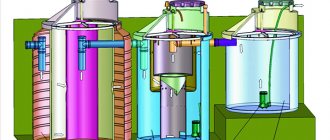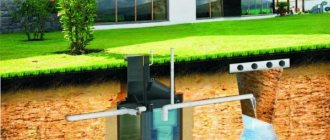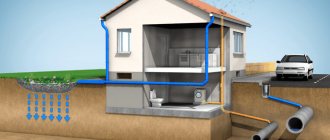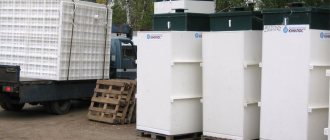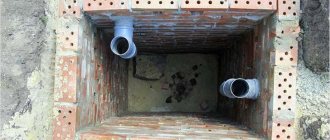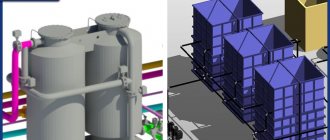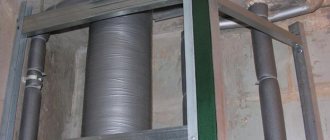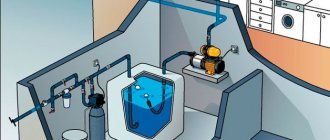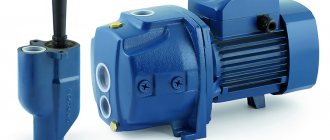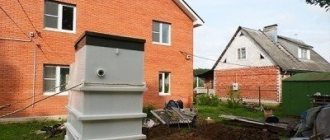The issue of arranging a suburban sewer system falls entirely on the shoulders of the property owners themselves. As a rule, cottage villages and gardening areas are located too far from centralized systems, which greatly complicates life.
Of course, at the dacha, especially if it is only spent in the summer, you can do without a shower, hot water and other benefits of civilization. But if you don’t arrange a place where wastewater will be discharged, then your vacation will become simply unbearable. Therefore, it is worth thinking about an autonomous sewer system. Fortunately, today there are plenty to choose from.
The simplest sewers
In this case we are talking about ordinary cesspools. They were popular more than 20 years ago and were used not only in dachas, but also for arranging the sewer system of houses in which people lived permanently.
This is the most primitive design, which is an ordinary pit covered with a wooden booth. Actually, this is an ordinary country toilet, into which dirty water after washing dishes and other waste were additionally drained. Everyone knows about the disadvantages of such structures. Firstly, complete unsanitary conditions, and secondly, an unpleasant smell. I also had to empty such a pit myself, and this is not the most pleasant task.
Later, modern dry toilets appeared, which can be installed both on the street and in the house. But to operate them you need to use very toxic drugs. The container must be constantly cleaned, and since the waste is impregnated with chemically aggressive substances, there is also the problem of their disposal.
Therefore, the best option is a plastic septic tank, a deep biological treatment station or a septic tank made of concrete rings. Before figuring out what to choose, let's consider the standard requirements for organizing such systems.
How to choose the right sewer for your home
There are three types of sewer systems
Drives- Septic tanks
- Autonomous treatment plants.
Selection factors
The choice of device depends on several factors:
- House with permanent or temporary residence
- Number of permanent residents
Having answered these questions, you can begin to make further clarifications.
Residential house
If the house has a small area and one or two people live in it, and therefore the water consumption is not high, then you can get by with a regular storage tank or make a septic tank with your own hands.
In case of high water consumption and the number of residents is more than two people, it is worth considering purchasing a septic tank or installing a local treatment plant.
House with temporary residence or cottage
Such houses provide accommodation during the warm season. Most often they are equipped with a dry toilet, which does not require a sewer system. And for drains from the kitchen and shower, a homemade cesspool is enough.
If a temporary residence is equipped with all the benefits of civilization, then it is reasonable to install a septic tank or storage tank.
Requirements for septic tanks in a suburban area
According to SNiP and SaniP there are clearly defined standards. The treatment facility should be located at a distance:
- At least 10 m from a residential building or other structures.
- At least 1.5 m from the border of the site (it is called a boundary or a ditch).
- No closer than 20 m from the well (and the wells of neighbors must also be taken into account).
- At least 25 m from water pipes.
- No closer than 5 m to the gas pipeline.
If we are talking about a small summer cottage plot of 6 acres, then it is very difficult to fulfill such requirements. But if you violate them and your neighbors complain about you, then such amateur activity will result in a fine.
Also, when choosing a system, you need to consider its performance. The minimum septic tank indicators should be 1 m3 per day, based on the assumption that a family of 3-4 people uses the sewerage system.
In addition, you need to calculate the volume of the treatment plant. Again, based on the number of residents. If we take into account that all household members use showers, sinks and toilets, then on average about 200 liters are consumed per person per day. Accordingly, to understand how much volume a septic tank will require, you need to multiply the number of residents (let’s say 3) by the average water consumption (0.2) and multiply all this by another three. We get 3x0.2x3=1.8 m3.
The best option is a septic tank made of concrete rings or plastic, or a biological treatment station. What to choose?
Construction of houses
182 votes
+
Vote for!
—
Vote against!
A pressing question that plagues everyone who wants to live in private country houses without the possibility of connecting to a central water supply and sewerage system is how to make an autonomous sewer system. After all, without it it is not possible to fully use such benefits of civilization as a bath, shower, kitchen sink, washing machine and much more. Sewage in a private house can be equipped in different ways, which we will talk about in this article. Choosing the right system that suits your individual conditions and needs is even more important than implementing it.
- What kind of sewerage system can there be - a private house with permanent and temporary residence
- Cesspool without bottom
- Sealed container - storage tank
- Single-chamber septic tank - the simplest option for soil treatment
- Two-chamber septic tank - overflow settling wells
- Septic tank with filtration field - biological and soil treatment
- Septic tank with biofilter - natural treatment station
- Septic tank with forced air supply - artificial treatment station
- Water supply and sewerage of a private house - general rules
- Sewerage in a private house: video - example
What kind of sewerage system can there be - a private house with permanent and temporary residence
The option for arranging a drainage system in private homes is selected depending on several conditions:
- House with permanent or temporary residence.
- How many people permanently live in the house?
- What is the daily water consumption per person in the house (depends on the number of water consumers, such as a bathtub, shower, toilet, sink, washbasin, washing machine, etc.)
- What is the groundwater level?
- What is the size of the site, how much space can be used for treatment systems.
- What is the structure and type of soil on the site.
- Climatic conditions of the area.
You can learn more about the requirements in the relevant sections of SanPin and SNiP.
Conventionally, all sewerage systems in a private house can be divided into only two types:
- Storage systems (cesspool without bottom, sealed container for waste).
- Wastewater treatment facilities (the simplest single-chamber septic tank with soil treatment, a two-chamber septic tank - overflowing wells with natural purification, a two-three-chamber septic tank with a filtration field, a septic tank with a biofilter, a septic tank (aeration tank) with a constant air supply).
Cesspool without bottom
The most ancient method of arranging a sewer system, proven over centuries and even millennia, is a cesspool. Some 50 - 70 years ago there was no alternative to this method. But people did not use as much water in private homes as they do today.
A cesspool is a well without a bottom. The walls of the cesspool can be made of brick, concrete rings, concrete or other material. Soil remains at the bottom. When wastewater from a house enters a pit, more or less clean water seeps into the soil, purifying itself. Fecal matter and other solid organic waste settles to the bottom and accumulates. Over time, the well becomes filled with solid waste, and then it needs to be cleaned.
Previously, the walls of the cesspool were not made waterproof; then, when the hole was filled, they simply buried it and dug a new one in another place.
I would like to immediately note that installing a sewer system in a private house using a cesspool is possible only if the average daily volume of wastewater is less than 1 m3. In this case, soil microorganisms that live in the soil and feed on organic matter have time to process the water that penetrates the soil through the bottom of the pit. If the volume of wastewater is greater than this norm, the water does not undergo sufficient purification, penetrates into the soil and pollutes groundwater. This risks contaminating wells and other water sources within a radius of 50 m. Adding microorganisms to the cesspool somewhat reduces the unpleasant odor emanating from it, and also speeds up the process of water purification. But, nevertheless, it is not worth the risk.
Conclusion . A cesspool without a bottom can be built if the house is visited 2-3 days a week and does not consume a lot of water. In this case, the groundwater level must be at least 1 m below the bottom of the pit, otherwise contamination of the soil and water source cannot be avoided. Despite the lowest cost of arrangement, a cesspool is not popular in modern country houses and cottages.
Sealed container - storage tank
A sealed container is installed on the site near the house, into which wastewater and waste from the entire house flow through pipes. This container can be ready-made, store-bought, and made of plastic, metal or other material. Or it can be assembled independently from concrete rings, the bottom is made of concrete, and the lid is made of metal. The main condition when installing a sewer system in a private house of this type is complete tightness. Pragma corrugated pipes are suitable for sewerage.
When the container is full, it must be cleaned. To do this, a sewer truck is called, the call of which costs from 15 to 30 USD. The frequency of emptying the container, as well as the required volume, depends on the amount of waste. For example, if 4 people permanently live in a house and use a bath, shower, sink, toilet, and washing machine, then the minimum volume of the storage tank should be 8 m3, and it will have to be cleaned every 10 to 13 days.
Conclusion . A sealed cesspool is one of the options for installing sewerage in a private house if the groundwater level in the area is high. This will completely protect the soil and water sources from possible contamination. The disadvantage of such a sewage system is that you will often have to call a sewer truck. To do this, from the very beginning it is necessary to correctly calculate the location of the container to ensure convenient access to it. The bottom of the hole or container should not be deeper than 3 m from the soil surface, otherwise the cleaning hose will not reach the bottom. The lid of the container must be insulated to protect the pipeline from freezing. For such a sewer system in a private house, the cost depends on the material of the container. The cheapest option would be to purchase used Eurocubes, the most expensive would be pouring concrete or brick. In addition there are monthly cleaning costs.
Single-chamber septic tank - the simplest option for soil treatment
A single-chamber septic tank is not far from the cesspool; it is often called that. It is a well, the bottom of which is filled with crushed stone in a layer of at least 30 cm, and on top of coarse sand in the same layer. Wastewater flows through pipes into a well, where the water, seeping through a layer of sand, crushed stone, and then soil, is purified by 50%. Adding sand and crushed stone improves the quality of water purification and partly feces, but does not radically solve the problem.
Conclusion . Conducting sewerage in a private house using a single-chamber septic tank is impossible with permanent residence and large volumes of wastewater. Only for houses with temporary residence and low groundwater levels. After some time, the crushed stone and sand will need to be completely replaced, as they will silt up.
Two-chamber septic tank - overflow settling wells
As one of the economical sewerage options that you can install yourself, the installation of overflow settling wells and filter wells is widely popular.
This sewage system in a private house consists of two wells: one with a sealed bottom, the second without a bottom, but with powder, as in the previous method (crushed stone and sand). Wastewater from the house flows into the first well, where solid organic waste and feces sink to the bottom, fatty waste floats to the surface, and more or less clarified water is formed between them. At a height of approximately 2/3 of the first well, it is connected to the second well by an overflow pipe, located slightly at an angle so that water can flow there freely. Partially clarified water enters the second well, where it percolates through a sprinkle of crushed stone, sand and soil, purifies even more and leaves.
The first well is a settling tank, and the second is a filter well. Over time, a critical mass of feces accumulates in the first well, to remove which it is necessary to call a sewer truck. This will have to be done approximately once every 4 – 6 months. To reduce the unpleasant odor, microorganisms are added to the first well that decompose feces.
Overflow sewer in a private house: photo - example
You can make a two-chamber septic tank yourself from concrete rings, concrete or brick, or you can purchase a ready-made (plastic) one from the manufacturer. In the finished two-chamber septic tank, additional cleaning will also occur using special microorganisms.
Conclusion . It is possible to install a sewer system in a private house from two overflow wells only if the groundwater level, even during a flood, is 1 m lower from the bottom of the second well. Ideal conditions are sandy or sandy loam soil on the site. After 5 years, the crushed stone and sand in the filter well will have to be replaced.
Septic tank with filtration field - biological and soil treatment
We move on to a description of more or less serious cleaning systems that allow you not to worry about environmental pollution.
This type of septic tank is one container divided into 2 - 3 sections or several separate well containers connected by pipes. Most often, having decided to install this type of sewer system, a factory-made septic tank is purchased.
In the first container, wastewater settles, as in the previous method (settling well). Through the pipe, partially clarified water flows into a second container or section, where anaerobic bacteria decompose organic residues. Even more clarified water reaches the filtration fields.
Filtration fields are areas underground where wastewater undergoes soil treatment. Thanks to the large area (about 30 m2), the water is purified by 80%. The ideal case is if the soil is sandy or sandy loam, otherwise you will have to equip an artificial filtration field made of crushed stone and sand. After passing through the filtration fields, the water is collected in pipelines and discharged into drainage ditches or wells. Trees or edible vegetables cannot be planted above the filtration fields; only a flower bed is allowed.
Over time, the fields become silted and need to be cleaned, or rather replaced with crushed stone and sand. You can imagine how much work will have to be done, and what your site will turn into after this.
Conclusion . Laying a sewer system in a private house, which requires the presence of a filtration field, is only possible if the groundwater level is below 2.5 - 3 m. Otherwise, this is a fairly constructive solution, provided there is sufficient free space. Also, do not forget that the distance from the filtration fields to water sources and residential buildings should be more than 30 m.
Septic tank with biofilter - natural treatment station
A deep cleaning station allows for complete installation of sewerage in a private house, even if the groundwater level is very high.
A septic tank is a container divided into 3 – 4 sections. It is better to purchase it from a trusted manufacturer, after consulting with professionals about the required volume and equipment. Of course, the price for such a sewer system in a private house is not the lowest, starting from 1200 USD.
In the first chamber of the septic tank, water settles, in the second, organic matter decomposes by anaerobic microorganisms, the third chamber serves for water separation, since in the fourth, organic matter decomposes with the help of aerobic bacteria, which need a constant flow of air. To do this, a pipe is mounted above the chamber, rising 50 cm above the ground level. Aerobic bacteria are added to a filter installed on the pipe leading from the third section to the fourth. In essence, this is the filtration field - only in miniature and concentrated. Due to the small area of water movement and the high concentration of microorganisms, the water is thoroughly purified up to 90 - 95%. This water can be safely used for technical needs - watering the garden, washing the car and much more. To do this, their fourth section is given a pipe leading either to a container for storing purified water, or to a drainage ditch or well, where it is simply absorbed into the ground.
Sewage treatment in a private house - operation diagram:
Conclusion . A septic tank with a biofilter is a good solution for a private home with permanent residence. Microorganisms can be added to the septic tank by simply pouring them into the toilet. There are no restrictions on the use of such a treatment plant. An undeniable advantage is that it does not require electricity. The only drawback is that sewerage installation in a private house requires permanent residence, since without the constant flow of wastewater, bacteria die. When new strains are introduced, they begin active activity only after two weeks.
Septic tank with forced air supply - artificial treatment station
An accelerated treatment station where natural processes occur artificially. Construction of a sewer system in a private house using an aeration tank will require supplying electricity to the septic tank to connect an air pump and air distributor.
Such a septic tank consists of three chambers or separate containers connected to each other. Water enters the first chamber through sewer pipes, where it settles and solid waste precipitates. Partially clarified water from the first chamber is pumped into the second.
The second chamber is actually an aeration tank; here water is mixed with activated sludge, which consists of microorganisms and plants. All microorganisms and bacteria in activated sludge are aerobic. It is for their full functioning that forced aeration is needed.
Water mixed with sludge enters the third chamber - a settling tank for deeper cleaning. The sludge is then pumped back into the aeration tank using a special pump.
Forced air supply provides fairly rapid treatment of wastewater, which can then be used for technical needs.
Conclusion . An aeration tank is an expensive but necessary pleasure in some cases. The price starts from 3700 USD. There are no restrictions on the installation of such sewerage. Disadvantages are the need for electricity and permanent residence, otherwise the activated sludge bacteria die.
Water supply and sewerage of a private house - general rules
The location of sewerage facilities is subject to certain restrictions.
The septic tank should be located:
- no closer than 5 m from a residential building;
- no closer than 20 - 50 m from the water source (well, borehole, reservoir);
- no closer than 10 m from the garden.
The residential building must be located at a distance:
- 8 m from filter wells;
- 25 m from filter fields;
- 50 m from aeration treatment plants;
- 300 m from drainage wells or stations.
The pipes leading to the septic tank must be insulated so that they do not freeze in winter. To do this, they are wrapped with heat-insulating material and inserted into asbestos-cement pipes. External sewerage installation in a private house is carried out with pipes with a diameter of 100 - 110 mm, the slope should be 2 cm by 2 m, i.e. 2°, in practice they do a little more – 5 – 7° (with a margin). But you shouldn’t joke with this matter, since a larger slope will lead to water quickly passing through the pipes, and feces will linger and clog them, and a smaller slope will not ensure the movement of wastewater through the pipes at all. It is advisable to lay the pipes so that there are no turns or corners. For internal wiring of sewer pipes, a diameter of 50 mm is sufficient. If the house has more than one floor, and baths, sinks, and a toilet are also installed on the upper floors, then a riser with a diameter of 200 mm is used to drain wastewater down.
If you decide that you can do the sewerage of a private house with your own hands, be sure to take into account all the restrictions of SanPin and SNiP regarding the location and design of the sewerage system. In order not to spoil relations with your neighbors, consider the location of their water sources and other buildings.
The sewerage project for a private house is extremely important; you should not try to do without it. Sewerage is not a system that tolerates approximateness. Contact design bureaus or architects, and let the professionals create a working design for you, taking into account all the characteristics of the soil, site, climate and operating conditions. It is better if this project is completed together with the project of the house itself before its construction begins. This will make installation much easier.
If you are interested in the question of how to make a sewer system in a private house with a high groundwater level , then based on all of the above, these could be the following options:
- Sealed container for waste accumulation.
- Septic tank with biofilter.
- Aeration treatment station (aeration tank).
The actual work of installing a sewer system in a private house is not that difficult. It is necessary to install pipes throughout the house that will collect wastewater from different sources, connect them into a collector and run them through the foundation or under it along the ground to the septic tank. You can do the excavation work yourself, or you can hire an excavator. But choosing the right sewerage system and drawing up a project is much more important.
Sewerage in a private house: video - example
Concrete septic tank
This is the cheapest and easiest option. In essence, this is a more modern version of the sump. Today there are a large number of concrete rings of different sizes on sale. Therefore, it will not be difficult to find exactly those that are suitable for the required volume of liquid.
Healthy! If the family grows, it will not be difficult to deepen the structure and add another ring.
But such a septic tank must be sealed. Otherwise, impurities will penetrate into the ground and poison it. If everything is done correctly and three chambers are organized, each of which will undergo a certain stage of waste treatment, then you will not have to frequently maintain such a structure. As a rule, such septic tanks use special bacteria that feed on organic components. At the output you get clarified water and compost.
Healthy! If you decide to independently organize a septic tank from concrete rings, then it is better to buy reinforced concrete products with a lid.
However, it is not enough to simply lay the rings on top of each other and fasten them with cement. We'll have to prepare the foundation. Think about the bottom. Another disadvantage is that this design will take up too much space. To organize an optimal three-chamber septic tank and maintain all the distances to buildings, wells and paths, you will have to rack your brains.
In addition, such structures are not recommended to be laid if the groundwater level is high. In this case, you cannot be sure of reliable sealing of the waste. What do people do in this case?
In such a situation, there are two options. In the first case, you can install a storage tank from metal barrels welded together. But in order not to worry about groundwater that rises in the spring, you will have to purchase a very large and heavy tank. It will not be installed without heavy equipment. In addition, the metal is susceptible to corrosion, and under the influence of active bacteria, rust will spread over the inner surface very quickly. In this case, it is more logical to install a ready-made plastic structure.
Plastic septic tank
Such products are usually made of high-strength polypropylene. This material is resistant to soil pressure and does not react to chemical reactions that occur inside it.
A septic tank has a chamber in which the wastewater first settles. During this process, heavier suspensions sink to the bottom or, on the contrary, float to the top, depending on their type. As a result, purer water is formed in the middle of the so-called liquid column. At the same level there is an overflow device, thanks to which the liquid flows into the next cleaning chamber. Thus, waste undergoes multi-level cleaning in an autonomous mode. There are also models that assume the presence of special anaerobic bacteria. During their life, waste begins to ferment. As a result, organic sediment accumulates at the bottom.
However, neither a plastic septic tank nor concrete rings are capable of providing the proper level of water purification so that it can be used, for example, for irrigation. You can’t just throw it into the ground. To do this, you will either have to call a vacuum cleaner (usually cleaning is required no more than once a year), or purchase a post-treatment system. To do this, it will be necessary to organize another treatment facility equipped with a sand and gravel filter.
But such systems have both pros and cons.
Advantages and disadvantages
If we talk about the advantages of such installations, it is worth highlighting:
- Full autonomy. The system does not require a power connection.
- Variety of models. You can purchase a ready-made solution for 2-4 cameras or make it yourself.
- Possibility of removing waste not only from the toilet, but also from the shower stall and sinks located in the house.
- Relatively low cost. Of course, a PVC septic tank will cost more than concrete rings, but it will cost less than a biological treatment plant.
- Easy to install.
Healthy! Simple installation is only possible if the soil absorbs water normally. Otherwise, the structure will need to be strengthened, which will cost additional money.
- Long service life. There are simply no complex mechanical components in plastic septic tanks, so there is simply nothing to break.
There were some downsides:
- Water must not be discharged into the soil.
- Long waste processing. It takes time for biologically active bacteria to process wastewater.
- Although it’s rare, you’ll still have to call the vacuum cleaners sometimes.
If you live outside the city permanently and have the opportunity to spend more money, then it would be more rational to install a more functional design.
Septic tanks with filtration field
Such a sewer system for a country house is distinguished by the complexity of its design and was developed in connection with tightening environmental management standards.
The structure includes:
- distribution well;
- settling tank;
- underground filtration fields consisting of pipes buried in sand and gravel soil.
This design goes through several stages of cleaning at once and depends on the type of soil. To a greater extent it is combined with sandy soil, and to a lesser extent with clay soil.
The advantage of the design is its long-term operation, reaching 10 years. The disadvantage lies in the need to use large areas of land for the construction of such a water purification structure.
Even if there are several purification devices in the design, it is still not always possible to achieve a high level of water purification from contaminants.
Deep biological treatment station
In fact, this is a more advanced septic tank, in which at the first stage of cleaning it also uses the method of settling waste. But after this, the partially clarified water undergoes biological treatment using oxygen, which is supplied to the chamber. Thanks to this, waste goes through the stages of decomposition and splitting into organic particles much faster and of better quality. As a result, at the output you get water that is 97-99% purified.
This is enough to use the liquid for irrigation or technical needs. This means that no additional treatment facilities will be required. However, such full-fledged systems also have pros and cons.
Designs with a biofilter
Septic tanks with a biofilter, in addition to the septic tank itself, also consist of a tank with a biofilter, inside of which there is a backfill made of foam plastic, expanded clay, and fibers. The biofilter creates an environment for the proliferation of anaerobic bacteria, which decompose elements of sewage water.
Thanks to the biofilter, high-quality bio-purification of sewage in a private house occurs, reaching values of 95%.
The design has many advantages:
- does not depend on electricity;
- easy to install;
- does not contribute to the spread of odors;
- does not require constant maintenance.
Example of an installed biofilter
For the active growth of microorganisms inside the structure, it is enough to pour the products containing them into the toilet.
The downside of this method is the need to constantly add biological products and the inability to use bleach, which has a detrimental effect on bacteria.
The design is expensive, but works better than devices without biofilters.
Advantages and disadvantages
Among the main advantages it is worth highlighting:
- The highest degree of purification (such results cannot be obtained with a concrete or plastic septic tank).
- Compactness. Despite their “oversized” name, such stations can be easily installed even in the most densely built-up areas.
- Zero waste. Water is discharged into the ground and there is no need for the services of vacuum cleaners.
- High performance. One station may be enough to serve several houses at once. Therefore, you can save money and chip in with your neighbors and install one system for several houses.
- Possibility of installation in any soil. The stations are installed successfully at any groundwater level.
But in fairness, it is worth noting the disadvantages:
- The need to connect to a source of electricity. Since such systems contain electrical equipment, the risk of breakdowns increases.
- The need for maintenance. You will have to call specialists 3-4 times a year to pump out the accumulated thick masses.
- High cost. If a good plastic septic tank will cost 7,000 - 15,000 rubles, and concrete rings are even cheaper, then the simplest deep cleaning station will cost at least 60,000 rubles.
The last disadvantages will again cost much less if you connect the equipment to several houses at once. Or you can purchase an additional pump that is built into the system and pump out the resulting sludge yourself. But such pumping equipment is not cheap.
Selection of pipes for autonomous sewerage
Before installing a sewerage system for a suburban area, it is necessary to select the right pipes, since the performance of the system and its service life will depend on this. According to building codes, the use of products from the following materials is permitted:
- cast iron;
- plastic;
- asbestos cement;
- reinforced concrete;
- ceramics.
Most often, plastic pipes are used to create a sewage system for a private home. This is due to such advantages as lack of corrosion, resistance to aggressive environments, and the ability to withstand heavy loads. Also, products made from polymer materials have a smooth inner surface, which minimizes the possibility of blockages.
Since sewer pipes are made from different types of plastic, it is worth paying attention to some parameters of these products. Features of polyvinyl chloride pipes include:
- To connect pipes you do not need to have a specialized tool. To connect, you just need to apply glue to the joints and correctly connect the structural elements.
- Pipes can be used to create both open and closed piping.
- Since polyvinyl chloride is one of the cheapest polymers, pipes have a low cost.
It is also worth taking a closer look at products made of polypropylene; they can be single- or multi-layer. The second type of pipe has a layer that is attached over polypropylene and consists of aluminum foil. The connection of such products occurs using fittings or welding.
When choosing an autonomous sewer system, it is worth remembering that the system requires connection to the electrical network and therefore is not installed in areas that are not constantly used.
Important! For welding polypropylene pipes, only specialized tools are used, which have nozzles of different diameters.
